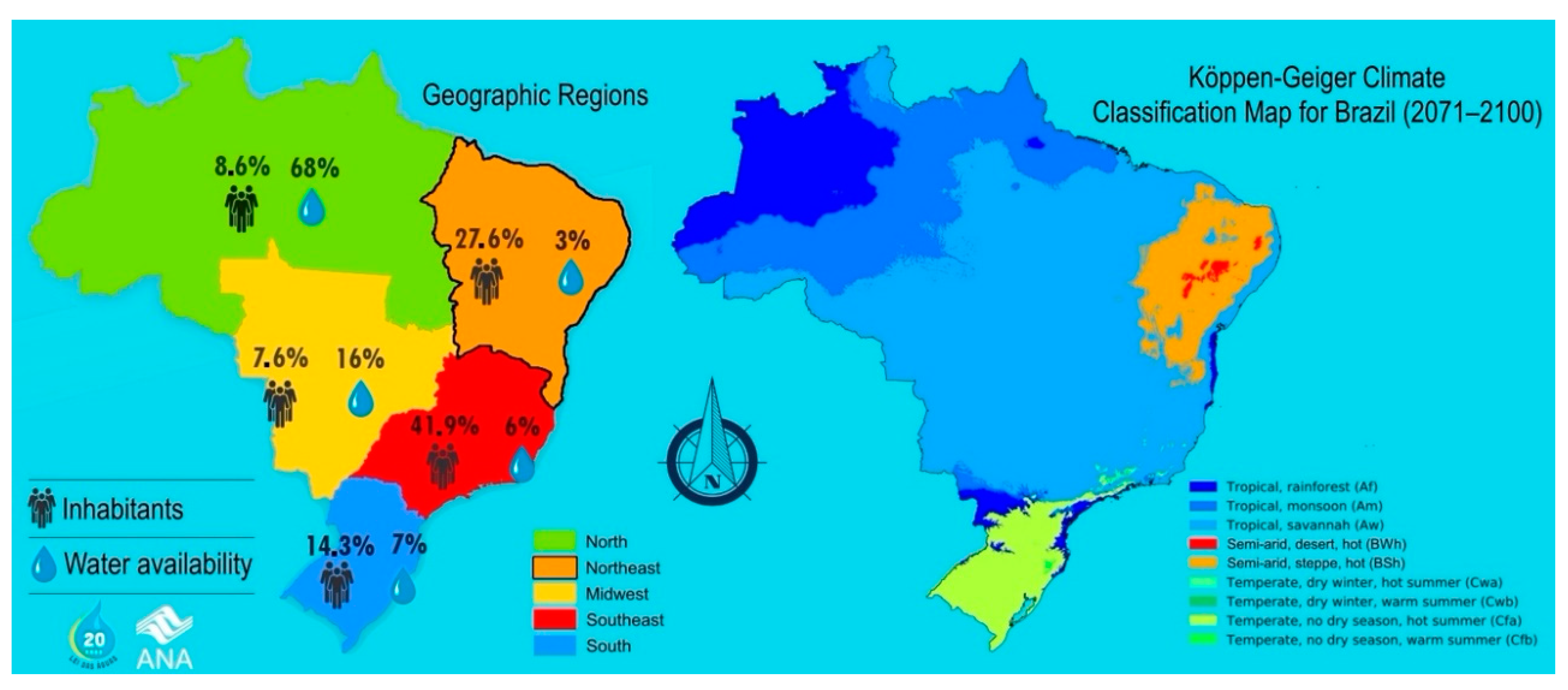Multi-Temporal Built-Up Grids of Brazilian Cities: How Trends and Dynamic Modelling Could Help on Resilience Challenges?
Abstract
1. Introduction
2. The “Natural Resilience” of the Northeastern Brazilian Cities
3. Materials and Methods
3.1. Cellular Automata Model: SIMLANDER
3.2. Cities Selection
3.3. Datasets and Influencing Factors
3.4. Methodology Overview
- (i)
- the “infilling” (increasing population density in the existing urban area);
- (ii)
- the “edge-expansion” or “extension” (urbanisation advancing from the edges of an existing urban area);
- (iii)
- “outlying” or “leap-frogging” (emergence of new urban patches that are isolated from existing urban areas).
3.5. Trend Analysis and Applications
3.5.1. Water Demand Estimates
3.5.2. Future Imperviousness Rates for Flood Simulations
4. Results and Discussions
4.1. Water Demand Applications
4.2. Flood Simulation Applications
5. Conclusions
Author Contributions
Funding
Data Availability Statement
Conflicts of Interest
References
- Seto, K.C.; Guneralp, B.; Hutyra, L.R. Global forecasts of urban expansion to 2030 and direct impacts on biodiversity and carbon pools. Proc. Natl. Acad. Sci. USA 2012, 109, 16083–16088. [Google Scholar] [CrossRef]
- Wu, J. Urban ecology and sustainability: The state-of-the-science and future directions. Landsc. Urban Plan. 2014, 125, 209–221. [Google Scholar] [CrossRef]
- Simpson, R. Introduction: A Green Economy for Green Cities. In The Economy of Green Cities; Springer: Dordrecht, The Netherlands, 2013; pp. 13–16. [Google Scholar]
- Khan, D.M.; Veerbeek, W.; Chen, A.S.; Hammond, M.J.; Islam, F.; Pervin, I.; Djordjević, S.; Butler, D. Back to the future: Assessing the damage of 2004 Dhaka flood in the 2050 urban environment. J. Flood Risk Manag. 2018, 11, S43–S54. [Google Scholar] [CrossRef]
- Gennaio, M.-P.; Hersperger, A.M.; Bürgi, M. Containing urban sprawl—Evaluating effectiveness of urban growth boundaries set by the Swiss Land Use Plan. Land Use Policy 2009, 26, 224–232. [Google Scholar] [CrossRef]
- Pesaresi, M.; Ehrlich, D.; Kemper, T.; Siragusa, A.; Florczyk, A.J.; Freire, S.; Corbane, C. Atlas of the Human Planet 2017 Global Exposure to Natural Hazards; Publications Office of the European Union: Luxembourg, 2017. [Google Scholar] [CrossRef]
- Corbane, C.; Politis, P.; Syrris, V.; Pesaresi, M. GHS Built-Up Grid, Derived from Sentinel-1 (2016), R2018A; Joint Research Centre (JRC): Ispra, Italy, 2018. [Google Scholar]
- Corbane, C.; Pesaresi, M.; Politis, P.; Syrris, V.; Florczyk, A.J.; Soille, P.; Maffenini, L.; Burger, A.; Vasilev, V.; Rodriguez, D.; et al. Big earth data analytics on Sentinel-1 and Landsat imagery in support to global human settlements mapping. Big Earth Data 2017, 1, 118–144. [Google Scholar] [CrossRef]
- Soares-Filho, B.S.; Nepstad, D.C.; Curran, L.M.; Cerqueira, G.C.; Garcia, R.A.; Ramos, C.A.; Voll, E.; McDonald, A.; Lefebvre, P.; Schlesinger, P. Modelling conservation in the Amazon basin. Nature 2006, 440, 520–523. [Google Scholar] [CrossRef]
- Alnsour, J.A. Managing urban growth in the city of Amman, Jordan. Cities 2016, 50, 93–99. [Google Scholar] [CrossRef]
- Gant, R.L.; Robinson, G.M.; Fazal, S. Land-use change in the ‘edgelands’: Policies and pressures in London’s rural–urban fringe. Land Use Policy 2011, 28, 266–279. [Google Scholar] [CrossRef]
- Soares-Filho, B.S.; Coutinho Cerqueira, G.; Lopes Pennachin, C. Dinamica—A stochastic cellular automata model designed to simulate the landscape dynamics in an Amazonian colonisation frontier. Ecol. Model. 2002, 154, 217–235. [Google Scholar] [CrossRef]
- van Vliet, J.; Hurkens, J.; White, R.; van Delden, H. An Activity-Based Cellular Automaton Model to Simulate Land-Use Dynamics. Environ. Plan. B Plan. Des. 2012, 39, 198–212. [Google Scholar] [CrossRef]
- Verburg, P.H.; Overmars, K.P. Dynamic Simulation of Land-Use Change Trajectories with the Clue-S Model. In Modelling Land-Use Change; Springer: Dordrecht, The Netherlands, 2007; pp. 321–337. [Google Scholar]
- Neumann, J.; Burks, A.W. Theory of Self-Reproducing Automata; University of Illinois press: Urbana, IL, USA, 1966. [Google Scholar]
- Conway, J. The game of life. Sci. Am. 1970, 223, 4. [Google Scholar]
- Stanganini, F.N.; de Lollo, J.A. O crescimento da área urbana da cidade de São Carlos/SP entre os anos de 2010 e 2015: O avanço da degradação ambiental. Urbe. Rev. Bras. Gestão Urbana 2018, 10, 118–128. [Google Scholar] [CrossRef]
- Marengo, J.A.; Cunha, A.P.; Soares, W.R.; Torres, R.R.; Alves, L.M.; de Barros Brito, S.S.; Cuartas, L.A.; Leal, K.; Ribeiro Neto, G.; Alvalá, R.C.S.; et al. Increase Risk of Drought in the Semiarid Lands of Northeast Brazil Due to Regional Warming above 4 °C. In Climate Change Risks in Brazil; Springer International Publishing: Cham, Switzerland, 2019; pp. 181–200. [Google Scholar]
- Campos, J.N.B. Paradigms and Public Policies on Drought in Northeast Brazil: A Historical Perspective. Environ. Manag. 2015, 55, 1052–1063. [Google Scholar] [CrossRef] [PubMed]
- Grande, M.; Galvão, C.; Miranda, L.; Rufino, I. Environmental equity as a criterion for water management. Proc. Int. Assoc. Hydrol. Sci. 2014, 364, 519–525. [Google Scholar] [CrossRef][Green Version]
- Beck, H.E.; Zimmermann, N.E.; McVicar, T.R.; Vergopolan, N.; Berg, A.; Wood, E.F. Present and future Köppen-Geiger climate classification maps at 1-km resolution. Sci. Data 2018, 5, 180214. [Google Scholar] [CrossRef] [PubMed]
- Agência Nacional de Águas (Brasil). Conjuntura dos Recursos Hídricos no Brasil 2019: Informe Anual; ANA: Brasília, Brazil, 2019.
- Maisonnave, F.; Prado, A. Nordeste: Seca Histórica já Dura Seis Anos e Ameaça Tornar-Se Regra No Semiárido. Available online: https://arte.folha.uol.com.br/ciencia/2018/crise-do-clima/nordeste/seca-historica-ja-dura-seis-anos-e-ameaca-tornar-se-regra-no-semiarido/ (accessed on 20 November 2020).
- Magalhães, A.R. Vida e seca no Brasil. In Secas No Brasil: Política e Gestão Proativas; Centro de Gestão e Estudos Estratégicos—CGEE: Brasília, Brazil, 2016; pp. 19–35. [Google Scholar]
- De Medeiros, M.D.; Zanella, M.E. Estudo das vazões e estimativas de inundações no Baixo-Açu-RN. Geo UERJ 2019, 34, e40946. [Google Scholar] [CrossRef]
- De Freitas, C.M.; Silva, D.R.X.; de Sena, A.R.M.; Silva, E.L.; Sales, L.B.F.; de Carvalho, M.L.; Mazoto, M.L.; Barcellos, C.; Costa, A.M.; Oliveira, M.L.C.; et al. Desastres naturais e saúde: Uma análise da situação do Brasil. Cien. Saude Colet. 2014, 19, 3645–3656. [Google Scholar] [CrossRef] [PubMed]
- de Sousa, M.J.C.; Rufino, I.A.A.; Alves, P.B.R.; Filho, M.N.M.B. Water shortage risk mapping: A GIS-MCDA approach for a medium-sized city in the Brazilian semi-arid region. Urban Water J. 2020, 17, 642–655. [Google Scholar] [CrossRef]
- Alves, P.B.R.; de Melo Filho, H.; Tsuyuguchi, B.B.; Rufino, I.A.A.; Feitosa, P.H.C. Mapping of flood susceptibility in Campina Grande county—PB: A spatial multicriteria approach. Bol. Ciências Geodésicas 2018, 24, 28–43. [Google Scholar] [CrossRef]
- Instituto Trata Brasil. Ranking do Saneamento; GO Associados: São Paulo, Brazil, 2018. [Google Scholar]
- Alves, P.B.R.; Rufino, I.A.A.; Feitosa, P.H.C.; Djordjević, S.; Javadi, A. Land-Use and Legislation-Based Methodology for the Implementation of Sustainable Drainage Systems in the Semi-Arid Region of Brazil. Sustainability 2020, 12, 661. [Google Scholar] [CrossRef]
- Alves, P.B.R.; Djordjevic, S.; Javadi, A.; Lucena, D.P.M.M.; Barbosa, G.A.; Lacerda, M.C.; Alvarenga, V.M.L.; Agra, S.T.M.C.; Simões, P.C.; Vieira, M.D.A.; et al. Evaluation of a socio-environmental approach for disaster risk management. In Proceedings of the Water Efficiency Conference, Bristol, UK, 3–4 September 2020; Ward, S., Staddon, C., Eds.; University of West of England: Bristol, UK, 2020. [Google Scholar]
- Thapa, R.B.; Murayama, Y. Scenario based urban growth allocation in Kathmandu Valley, Nepal. Landsc. Urban Plan. 2012, 105, 140–148. [Google Scholar] [CrossRef]
- Gonzalez-Aguilera, D.; Crespo-Matellan, E.; Hernandez-Lopez, D.; Rodriguez-Gonzalvez, P. Automated Urban Analysis Based on LiDAR-Derived Building Models. IEEE Trans. Geosci. Remote Sens. 2013, 51, 1844–1851. [Google Scholar] [CrossRef]
- Nyamekye, C.; Kwofie, S.; Ghansah, B.; Agyapong, E.; Boamah, L.A. Assessing urban growth in Ghana using machine learning and intensity analysis: A case study of the New Juaben Municipality. Land Use Policy 2020, 99, 105057. [Google Scholar] [CrossRef]
- Mondal, B.; Das, D.N.; Dolui, G. Modeling spatial variation of explanatory factors of urban expansion of Kolkata: A geographically weighted regression approach. Model. Earth Syst. Environ. 2015, 1, 29. [Google Scholar] [CrossRef]
- Triantakonstantis, D.; Mountrakis, G.; Wang, J. A Spatially Heterogeneous Expert Based (SHEB) Urban Growth Model using Model Regionalisation. J. Geogr. Inf. Syst. 2011, 3, 195–210. [Google Scholar] [CrossRef]
- Aburas, M.M.; Ho, Y.M.; Ramli, M.F.; Ash’aari, Z.H. The simulation and prediction of spatio-temporal urban growth trends using cellular automata models: A review. Int. J. Appl. Earth Obs. Geoinf. 2016, 52, 380–389. [Google Scholar] [CrossRef]
- Liao, J.; Shao, G.; Wang, C.; Tang, L.; Huang, Q.; Qiu, Q. Urban sprawl scenario simulations based on cellular automata and ordered weighted averaging ecological constraints. Ecol. Indic. 2019, 107, 105572. [Google Scholar] [CrossRef]
- Hewitt, R.; Pacheco, J.D.; Gómez, B.M. A Cellular Automata Land Use Model for the R Software Environment (Weblog). Available online: https://simlander.wordpress.com (accessed on 10 May 2020).
- Hewitt, R.; Díaz Pacheco, J.; Moya Gómez, B. APoLUS/SIMLANDER Updated Versions Released. Available online: https://simlander.wordpress.com/2020/04/01/apolus-simlander-updated-versions-released/ (accessed on 10 May 2020).
- Hermanns, T.; Helming, K.; König, H.J.; Schmidt, K.; Li, Q.; Faust, H. Sustainability impact assessment of peatland-use scenarios: Confronting land use supply with demand. Ecosyst. Serv. 2017, 26, 365–376. [Google Scholar] [CrossRef]
- De Nys, E.; Engle, N.L.; Quintana, C. A Framework and Convening Power. In Drought in Brazil: Proactive Management and Policy; De Nys, E., Engle, N.L., Magalhães, A.R., Eds.; CRC Press: Boca Raton, FL, USA, 2016; pp. 27–35. [Google Scholar]
- Filho, F.D.A.S.; Formiga-Johnsson, R.M.; Studart, T.M.D.C.; Abicalil, M.T. From Drought to Water Security: Brazilian Experiences and Challenges. In Global Water Security: Lessons Learnt and Long-Term Implications; Springer: Singapore, 2018; pp. 233–265. [Google Scholar]
- Marengo, J.A.; Cunha, A.P.; Alves, L.M. A seca de 2012-15 no semiárido do Nordeste do Brasil no contexto histórico. Climanálise 2016, 3, 49–54. [Google Scholar]
- Oliveira, D.H.M.C.; Lima, K.C. What is the return period of intense rainfall events in the capital cities of the northeast region of Brazil? Atmos. Sci. Lett. 2019, 20. [Google Scholar] [CrossRef]
- Cemaden (Centro Nacional de Monitoramento e Alertas de Desastres Naturais). Available online: http://www.cemaden.gov.br/municipios-monitorados-2/ (accessed on 15 December 2020).
- SNIS (Sistema Nacional de Informações sobre Saneamento). Available online: http://www.snis.gov.br/ (accessed on 15 December 2020).
- Salinas, C.E.T.; de Oliveira, V.P.V.; Brito, L.; Ferreira, A.V.; de Araújo, J.C. Social impacts of a large-dam construction: The case of Castanhão, Brazil. Water Int. 2019, 44, 871–885. [Google Scholar] [CrossRef]
- Suassuna, J. Açude de Boqueirão Atinge Seu Ponto Mais Crítico e Entra No Volume Morto. Available online: http://www.suassuna.net.br/2016/02/acude-de-boqueirao-atinge-seu-ponto.html (accessed on 24 November 2020).
- Redação GNEWS. Abastecimento: Com Baixa No rio Piranhas-Açu, Caern Intensifica Rodízio em Três Cidades do Seridó. Available online: https://guamarenews.com/abastecimento-com-baixa-no-rio-piranhas/ (accessed on 15 November 2020).
- Júnior, P. Chuvas Ocasionam Alagamento e Impedem Passagem de Veículos em Frente ao Cemitério do Bairro Boa Passagem. Available online: https://correiodoserido.com.br/chuvas-ocasionam-alagamento-e-impedem-passagem-de-veiculos-em-frente-ao-cemiterio-do-bairro-boa-passagem/ (accessed on 10 December 2020).
- Antoni, J.-P.; Vuidel, G.; Omrani, H.; Klein, O. Geographic Cellular Automata for Realistic Urban form Simulations: How Far Should the Constraint be Contained? In The Mathematics of Urban Morphology; Birkhäuser: Cham, Switezerland, 2019; pp. 147–162. [Google Scholar]
- Kong, F.; Yin, H.; Nakagoshi, N.; James, P. Simulating urban growth processes incorporating a potential model with spatial metrics. Ecol. Indic. 2012, 20, 82–91. [Google Scholar] [CrossRef]
- Li, F.; Wang, L.; Chen, Z.; Clarke, K.C.; Li, M.; Jiang, P. Extending the SLEUTH model to integrate habitat quality into urban growth simulation. J. Environ. Manag. 2018, 217, 486–498. [Google Scholar] [CrossRef] [PubMed]
- Braimoh, A.K.; Onishi, T. Spatial determinants of urban land use change in Lagos, Nigeria. Land Use Policy 2007, 24, 502–515. [Google Scholar] [CrossRef]
- IBGE. Grade Estatística. Available online: https://mapasinterativos.ibge.gov.br/grade/default.html (accessed on 5 June 2020).
- Shi, Y.; Sun, X.; Zhu, X.; Li, Y.; Mei, L. Characterising growth types and analysing growth density distribution in response to urban growth patterns in peri-urban areas of Lianyungang City. Landsc. Urban Plan. 2012, 105, 425–433. [Google Scholar] [CrossRef]
- Gutiérrez, A.P.A.; Engle, N.L.; De Nys, E.; Molejón, C.; Martins, E.S. Drought preparedness in Brazil. Weather Clim. Extrem. 2014, 3, 95–106. [Google Scholar] [CrossRef]
- Diário de Pernambuco. Racionamento de Água em Caruaru é Reduzido em Cinco Dias. Available online: https://www.diariodepernambuco.com.br/noticia/vidaurbana/2017/06/racionamento-de-agua-em-caruaru-e-reduzido-em-cinco-dias.html (accessed on 23 December 2020).
- SNIS (Sistema Nacional de Informações sobre Saneamento). Diagnóstico dos Serviços de Água e Esgotos—2018. Available online: http://www.snis.gov.br/diagnostico-anual-agua-e-esgotos/diagnostico-dos-servicos-de-agua-e-esgotos-2018 (accessed on 14 May 2020).
- Zubaidi, S.L.; Ortega-Martorell, S.; Al-Bugharbee, H.; Olier, I.; Hashim, K.S.; Gharghan, S.K.; Kot, P.; Al-Khaddar, R. Urban Water Demand Prediction for a City That Suffers from Climate Change and Population Growth: Gauteng Province Case Study. Water 2020, 12, 1885. [Google Scholar] [CrossRef]
- Zheng, H.; Zhou, W.; Zhang, L.; Li, X.; Cheng, J.; Ding, Z.; Xu, Y.; Hu, W. Urban Water Consumption Patterns in an Adult Population in Wuxi, China: A Regression Tree Analysis. Int. J. Environ. Res. Public Health 2020, 17, 2983. [Google Scholar] [CrossRef]
- Vamvakeridou-Lyroudia, L.S.; Chen, A.S.; Khoury, M.; Gibson, M.J.; Kostaridis, A.; Stewart, D.; Wood, M.; Djordjevic, S.; Savic, D.A. Assessing and visualising hazard impacts to enhance the resilience of Critical Infrastructures to urban flooding. Sci. Total Environ. 2020, 707, 136078. [Google Scholar] [CrossRef]
- Guidolin, M.; Chen, A.S.; Ghimire, B.; Keedwell, E.C.; Djordjević, S.; Savić, D.A. A weighted cellular automata 2D inundation model for rapid flood analysis. Environ. Model. Softw. 2016, 84, 378–394. [Google Scholar] [CrossRef]
- Wang, Y.; Chen, A.S.; Fu, G.; Djordjević, S.; Zhang, C.; Savić, D.A. An integrated framework for high-resolution urban flood modelling considering multiple information sources and urban features. Environ. Model. Softw. 2018, 107, 85–95. [Google Scholar] [CrossRef]
- Webber, J.L.; Booth, G.; Gunasekara, R.; Fu, G.; Butler, D. Validating a rapid assessment framework for screening surface water flood risk. Water Environ. J. 2019, 33, 427–442. [Google Scholar] [CrossRef]
- Wong, T.H.F.; Brown, R.R. The water sensitive city: Principles for practice. Water Sci. Technol. 2009, 60, 673–682. [Google Scholar] [CrossRef] [PubMed]
- McCuen, R.H.; Johnson, P.A.; Ragan, R.M. Hydrology, Hydraulic Design Series No. 2. FHWA–SA–96–067; Federal Highway Administration, US Department of Transportation: Washington, DC, USA, 1996.
- G1 Ceará. Consumo de Água cai na Grande Fortaleza Após Cobrança de Tarifa. Available online: http://g1.globo.com/ceara/noticia/2016/03/consumo-de-agua-reduz-na-grande-fortaleza-apos-cobranca-de-tarifa.html (accessed on 21 December 2020).
- Alves, P.B.R.; Cordão, M.J.D.S.; Djordjević, S.; Javadi, A.A. Place-Based Citizen Science for Assessing Risk Perception and Coping Capacity of Households Affected by Multiple Hazards. Sustainability 2021, 13, 302. [Google Scholar] [CrossRef]
- CHOW, V.T. Open-Channel Hydraulics; McGraw-Hill: New York, NY, USA, 1959. [Google Scholar]
- UK Environment Agency. What Is the Updated Flood Map for Surface Water; UK Environment Agency: Bristol, UK, 2013.
- Ehrlich, D.; Kemper, T.; Pesaresi, M.; Corbane, C. Built-up area and population density: Two Essential Societal Variables to address climate hazard impact. Environ. Sci. Policy 2018, 90, 73–82. [Google Scholar] [CrossRef]
- Libanio, P.A.C. Two decades of Brazil’s participatory model for water resources management: From enthusiasm to frustration. Water Int. 2018, 43, 494–511. [Google Scholar] [CrossRef]
- Miranda, L.I.B.D. A Crise Hidrica e a Gestão das Águas Urbanas na Bacia Hidrográfica do Rio Paraíba. In Proceedings of the XVII ENANPUR, São Paulo, Brazil, 22–26 May 2017. [Google Scholar]

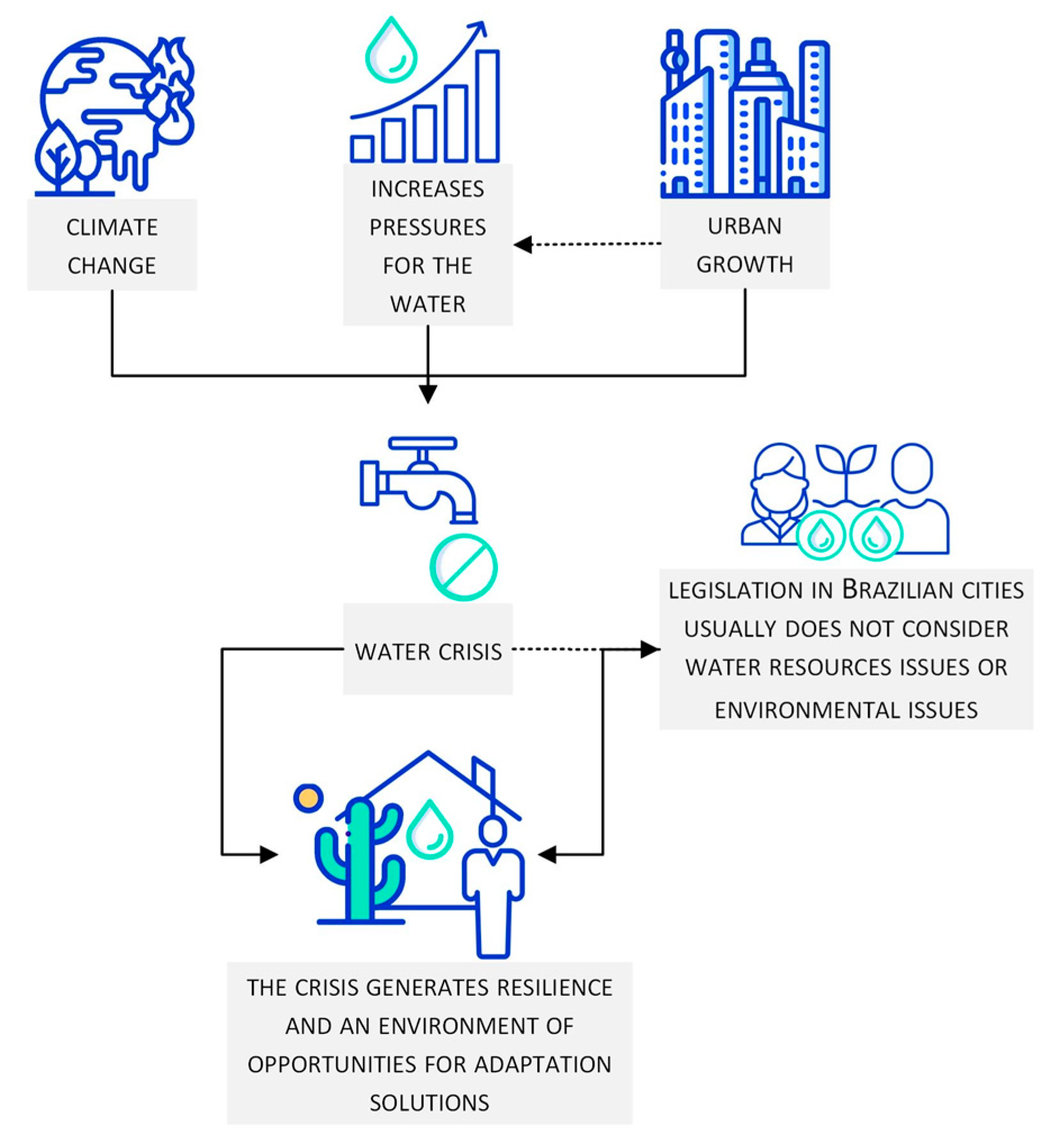
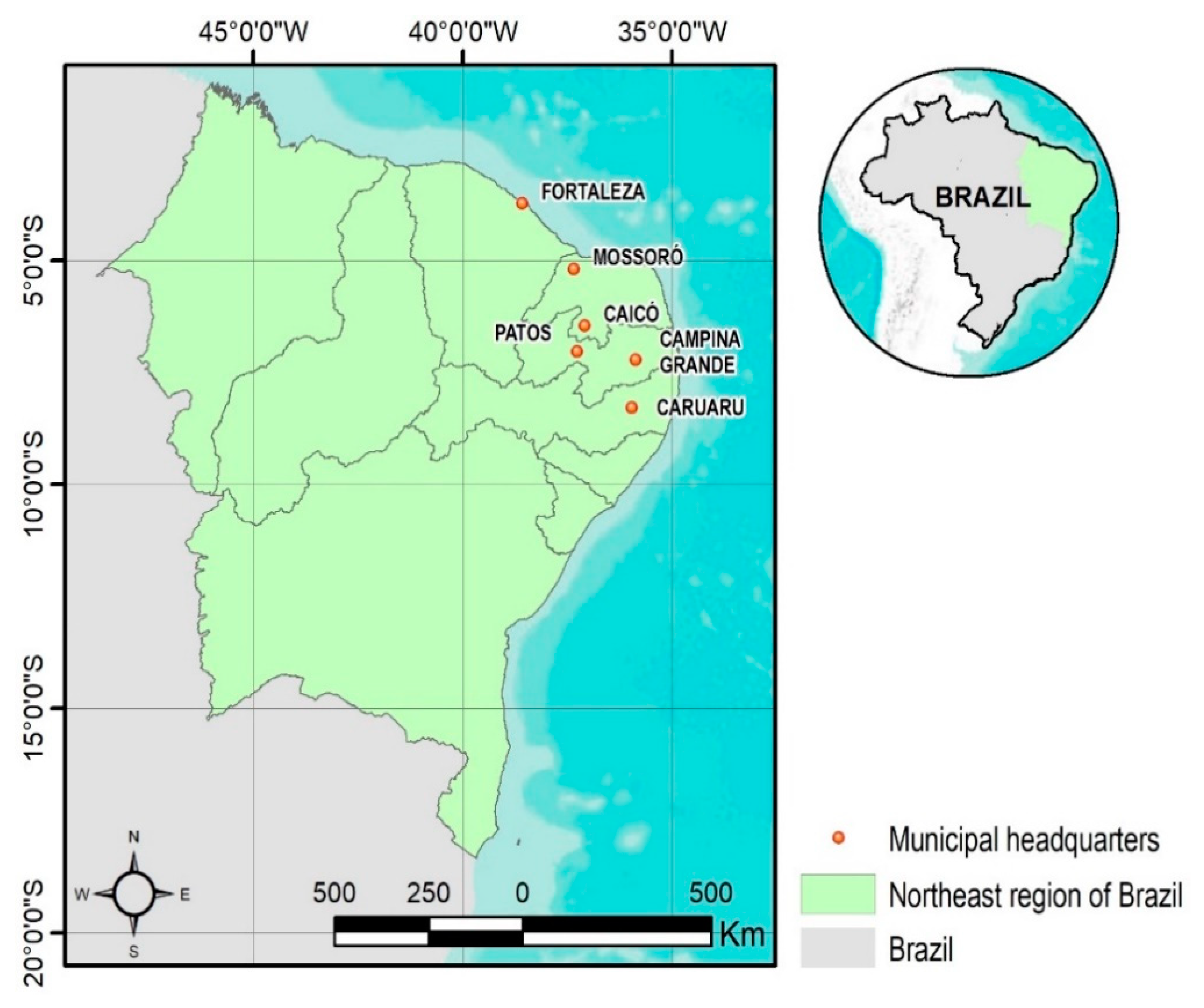
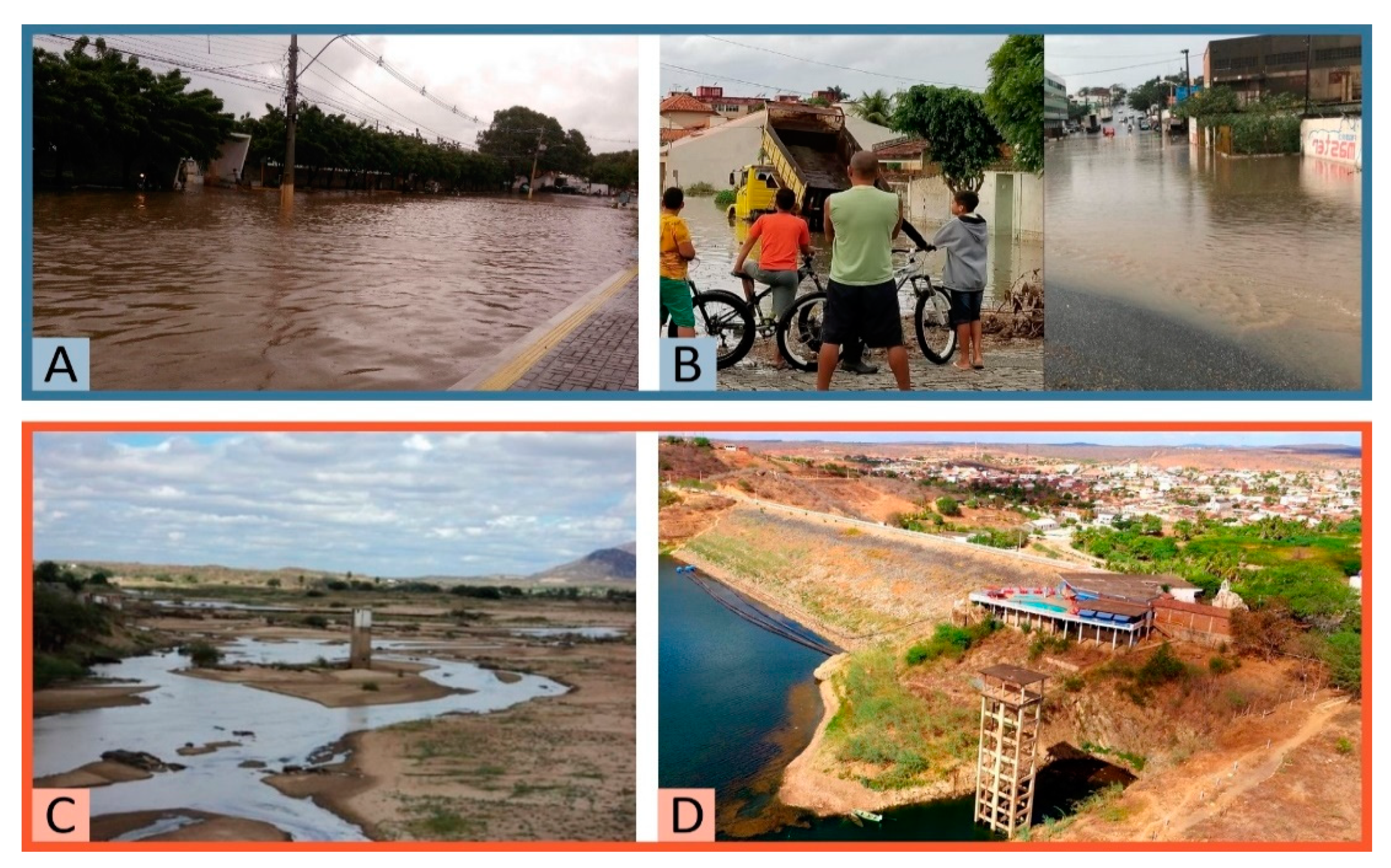

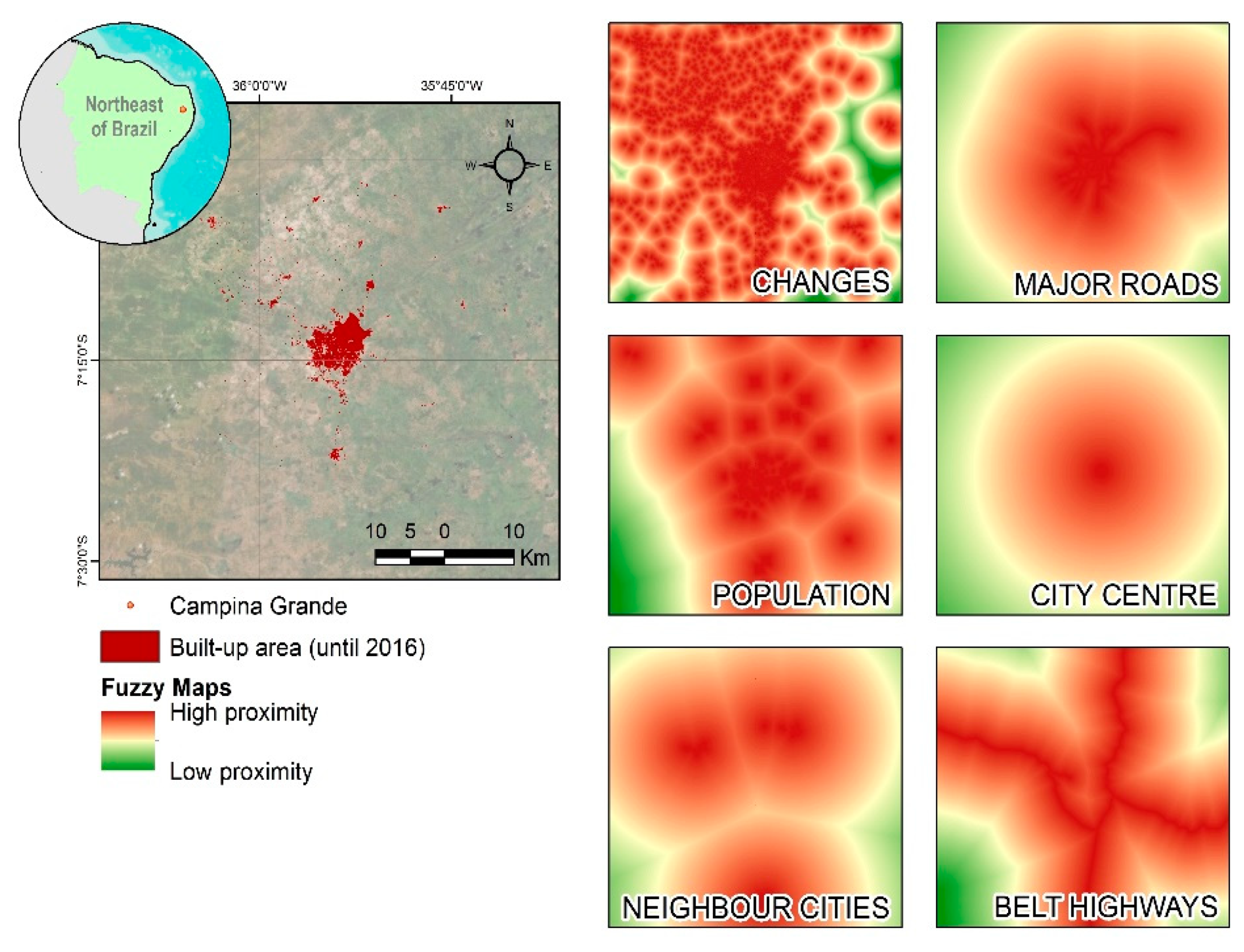


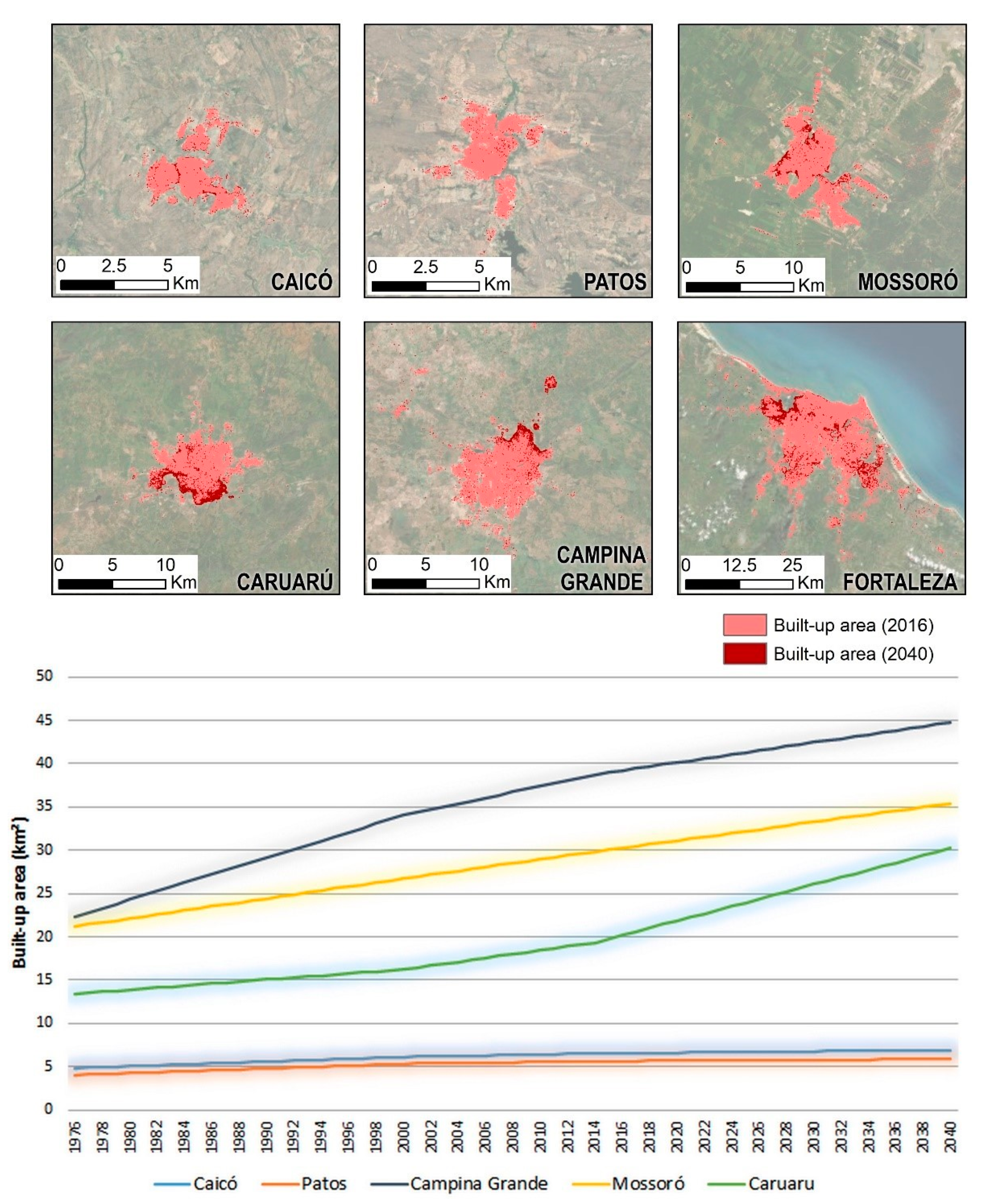
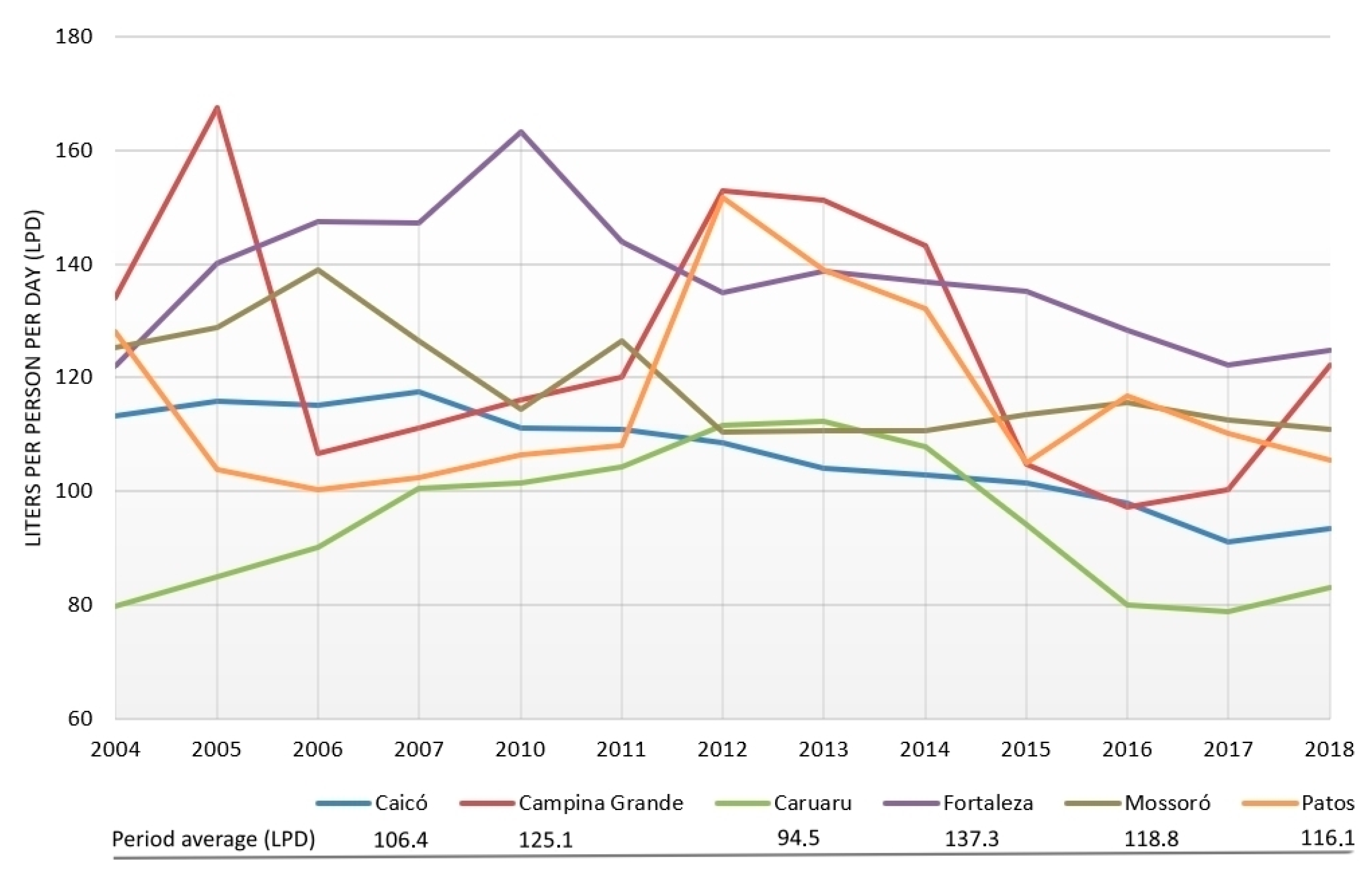
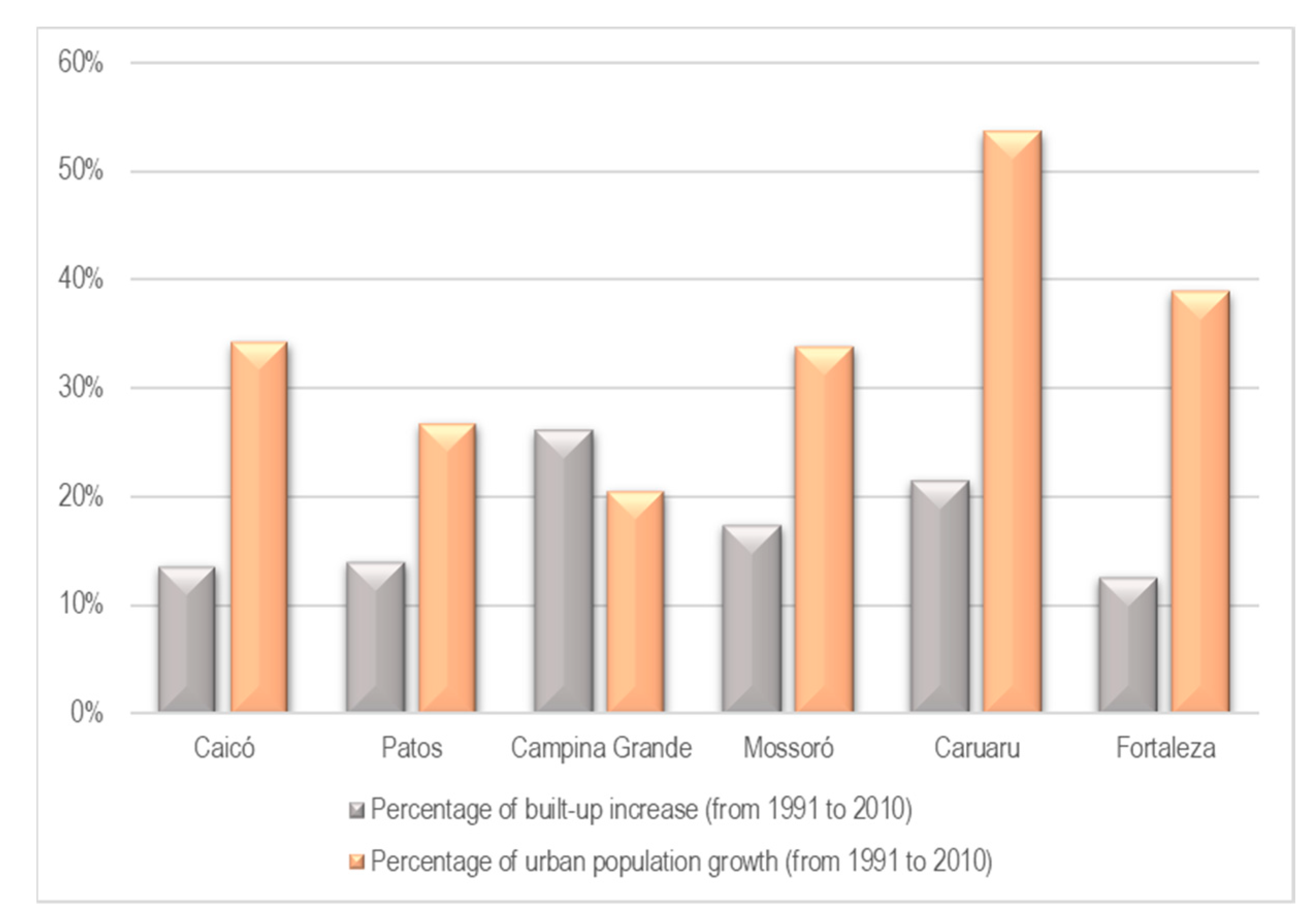
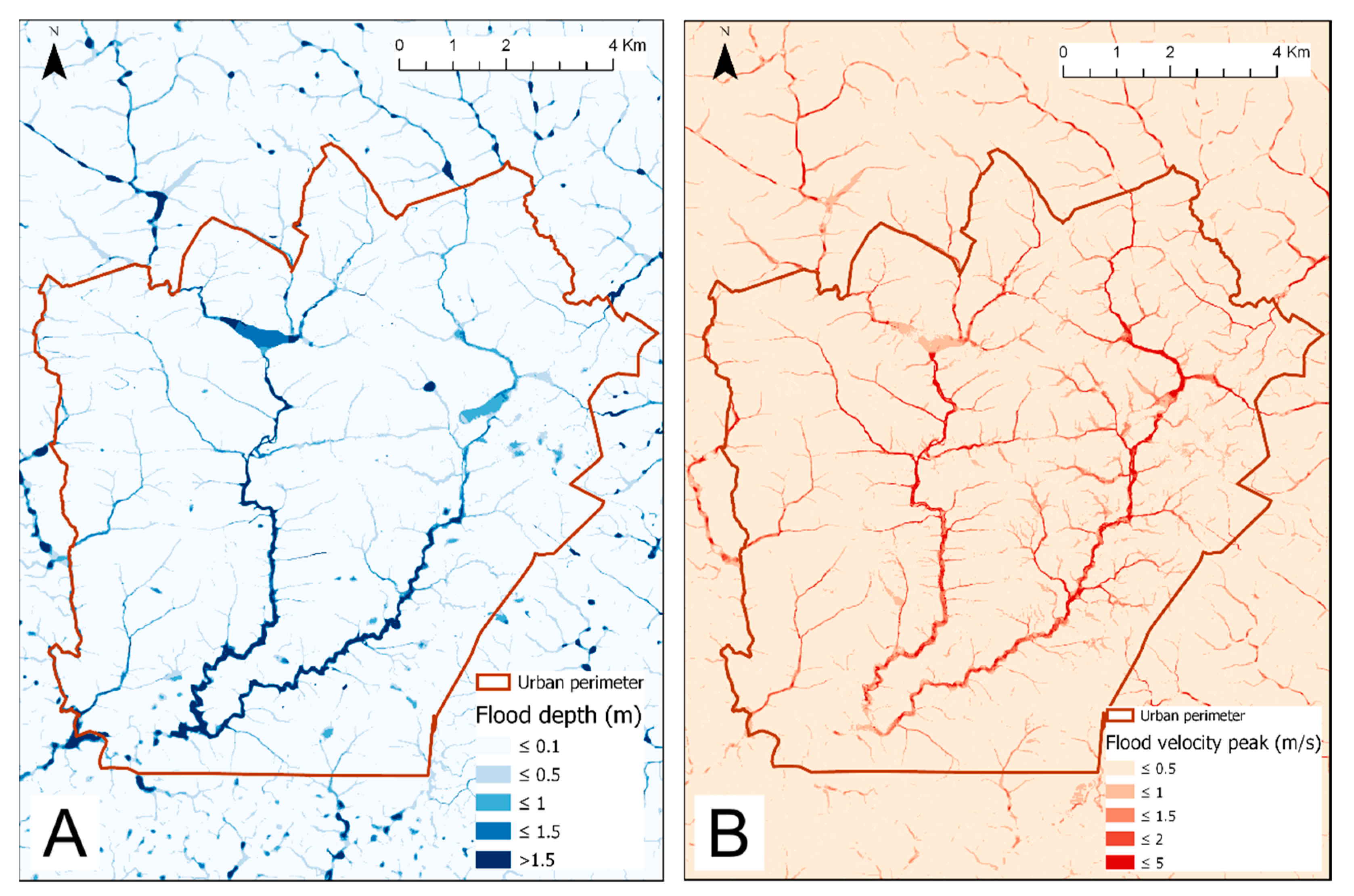
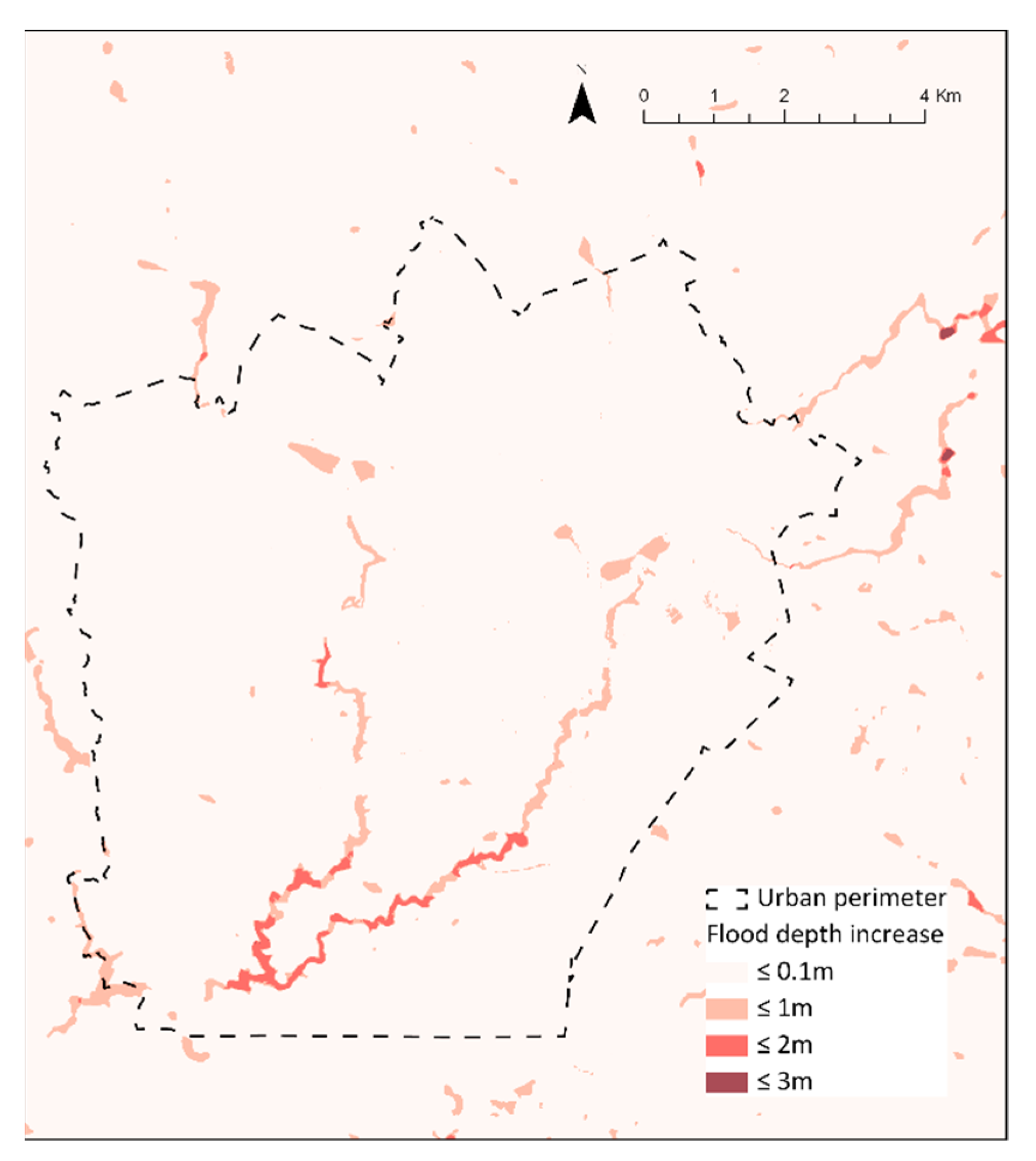

| Criterion | Description |
|---|---|
| Population threshold (over 50 thousand people) | Most of the towns in NEB are small cities (under 50 thousand people), and there are some “spots” that have been attracting urban growth over recent decades. Population information was collected through the Brazilian Institute of Geography and Statistics (IBGE). |
| The occurrence of water-related hazards | This is mainly related to water scarcity and floods. The databases about floods are surrounded by uncertainty, but there has been national risk disaster mapping [46] of high-risk areas in those selected cities (as well as in many others in the NEB). The water supply services can be evaluated by a national database [47], and the latest information was considered in the selection of the cities. |
| Degree of urbanisation (over 70%) | Considering the whole NEB, more than 70% of the population lives in an urban area. This study selected only cities with the degree of urbanisation above 70%. Although initially the study was focused on “non-capital” cities, all NEB capitals face some level of troubles regarding floods seasonally. In this sense, having one capital sample could improve the outreach of our research. The chosen capital (Fortaleza-CE) is one of the NEB capitals more dependent on semi-arid water resources. Past policymakers’ choices made the water supply highly dependent on Castanhão lake, one of the most affected surface reservoirs in the last drought [48]. |
| Dynamic movement attraction | This characteristic is due to the movement attraction that some cities have because of the importance within a state. For example, Campina Grande and Caruaru are the second-most urbanised cities in Paraiba and Pernambuco states, respectively (IBGE). Both cities attract visitors due to commercial, industrial, cultural, and education activities. This increases the dynamic in each city and makes the prediction even more critical for the management |
| Previous studies and proximity for future assessments | Due to the high applicability of the built-up information in further studies, this work also considered the proximity and previous knowledge and studies about them [27,30]. It shall facilitate the development of field studies in the future. |
| Cities | Population (2020) | Area (km2) | Degree of Urbanisation (%) | State Ranking (Population) |
|---|---|---|---|---|
| Fortaleza—CE | 2,669,342 | 312.3 | 91.8 | 1° |
| Campina Grande—PB | 409,731 | 591.6 | 89.6 | 2° |
| Mossoró—RN | 297,378 | 2099.3 | 79.7 | 2° |
| Caruaru—PE | 361,118 | 920.6 | 77.4 | 2° |
| Caicó—RN | 67,952 | 1228.5 | 84.5 | 7° |
| Patos—PB | 107,605 | 472.8 | 90.4 | 4° |
| GHSL Data/Collection | Description | Technical Information |
|---|---|---|
| GHS_BUILT_LDSMT_GLOBE_R2018A | built-up up to the 1975 period built-up during the 1975 to 1990 period built-up during the 1990 to 2000 period built-up during the 2000 to 2014 period | Multitemporal classification of built-up presence from Landsat images; 30 m of resolution—Pseudo Mercator (EPSG:3857) |
| GHS_BUILT_S1NODSM_GLOBE_R2018A | built-up presence as derived from Sentinel1 image collections (2016) | Built-up surfaces derived from global Sentinel-1 Synthetic Aperture Radar (SAR) satellite data, collected during 2016; 20 m of resolution—Spherical Mercator (EPSG:3857) |
| Variables | Assumptions | References |
|---|---|---|
| Distance to city centre | The more is the proximity to the city centre is an area, the more attractive it is to changes. Land-use changes tend to be more frequent in the NEB city centres, as well as the number of buildings and imperviousness. The assumption here is: the built-up areas increase as long they are close to the city centre | [13,14] [32,38,39,40,41,42,43,44] [52,53,54,55] |
| Distance to main roads | Changes are more substantial and often close to the main roads. Accessibility attracts changes in urban areas. | |
| Distance to belt highways | The cities’ fringes are continually changing in NEB. Usually close to the belt highways. Those areas can be becoming attractive for the easy access options in the edge of the traffic of a city. | |
| Distance to other cities | The neighbourhood influence is strong in NEB. There is a lot of economic and social dependence between the cities, which is a change attractor. The nearer to other cities, the more the possibility to change increases. | |
| Population density | A statistical grid of population density [56] was used and the closer to more populated pixels, the more the possibility to change increases. Usually, areas with a higher number of buildings and high density levels tend to attract changes. | |
| Inherent dynamic (changes) | For each city, the distance to the pixels that changed (more attractive pixel) was considered. The 2014 grid and 1975 grid were compared, and all changed pixels were change attractor pixels. |
Publisher’s Note: MDPI stays neutral with regard to jurisdictional claims in published maps and institutional affiliations. |
© 2021 by the authors. Licensee MDPI, Basel, Switzerland. This article is an open access article distributed under the terms and conditions of the Creative Commons Attribution (CC BY) license (http://creativecommons.org/licenses/by/4.0/).
Share and Cite
Rufino, I.; Djordjević, S.; Costa de Brito, H.; Alves, P.B.R. Multi-Temporal Built-Up Grids of Brazilian Cities: How Trends and Dynamic Modelling Could Help on Resilience Challenges? Sustainability 2021, 13, 748. https://doi.org/10.3390/su13020748
Rufino I, Djordjević S, Costa de Brito H, Alves PBR. Multi-Temporal Built-Up Grids of Brazilian Cities: How Trends and Dynamic Modelling Could Help on Resilience Challenges? Sustainability. 2021; 13(2):748. https://doi.org/10.3390/su13020748
Chicago/Turabian StyleRufino, Iana, Slobodan Djordjević, Higor Costa de Brito, and Priscila Barros Ramalho Alves. 2021. "Multi-Temporal Built-Up Grids of Brazilian Cities: How Trends and Dynamic Modelling Could Help on Resilience Challenges?" Sustainability 13, no. 2: 748. https://doi.org/10.3390/su13020748
APA StyleRufino, I., Djordjević, S., Costa de Brito, H., & Alves, P. B. R. (2021). Multi-Temporal Built-Up Grids of Brazilian Cities: How Trends and Dynamic Modelling Could Help on Resilience Challenges? Sustainability, 13(2), 748. https://doi.org/10.3390/su13020748






